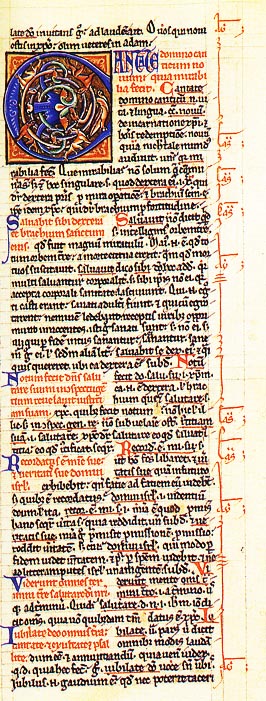Commentary Manuscripts
Contents: Introduction * Noteworthy Commentaries * Noteworthy Commentary Manuscripts
IntroductionMost manuscripts of the New Testament are straight-text manuscripts. The price of books being what it was, anything unnecessary was carefully eliminated, since additional text required more writing material and more scribal time. But while manuscripts with commentaries are not common, they are not rare, either. Many commentaries, such as those of Oecumenius (and his imitator the pseudo-Oecumenius) and Andreas of Cæsarea, were intimately linked to the Bible text. Anyone who wanted to read those commentaries would need the text at hand. Why not combine them in a single volume? The result is that some 20% of all New Testament manuscripts -- nearly 600 all told -- include some sort of regular commentary. Some contain commentaries from only one author (e.g. the dozens of manuscripts of the Apocalypse which also contain Andreas's commentary.) Others contain a catena, or chain commentary (from the Latin word for "chain, fetter"). Catena manuscripts contain comments from several sources linked into the text; hence the title. In addition, a number of manuscripts are fitted with commentaries which are not so closely associated with the text. An example is 1739, which has hundreds of comments from various sources in the margin. The earliest commentary manuscript is the uncial Ξ, while the most important textually (and one of the most important for its commentary) is 1739. Von Soden was of the opinion that commentary manuscripts formed a special class of manuscripts, and classified commentary manuscripts solely on the basis of the commentary, without examining the text. Maurice Robinson, based on his examination of manuscripts of John in the vicinity of the story of the Adulteress, agrees in part: "The interspersed type of commentary in my opinion should never be considered in the same ballpark as a 'continuous-text' MS, simply because it is not such, even if the complete biblical text can be extracted therefrom. Such interspersed commentaries also stem directly from their archetype in almost all copies, and the only item of text-critical importance is recovery of the archetype text of that commentator... ([e.g.] Theophylact, Euthymius Zigabenus, or Niketas), and the many MSS of such a commentator say nothing much beyond what the patristic archetype was, so thus they are not really 'NT' MSS even though counted as such in the list. "Commentary MSS in which the catena or commentary surrounds the biblical text are a different matter, and these should be counted as continuous-text MSS. In fact some of this category were in unfinished state as I examined them on microfilm, and it was clear how the process operated: the biblical text was copied first in a centered portion of the page; the complete biblical book was finished; and only then was the catena or commentary added, often from another source MS in which the text reflected in the commentary often differed from that in the biblical text of the new MS...." Nonetheless, no detailed check has been performed on von Soden's thesis (Wisse, e.g., did not profile commentary manuscripts). Noteworthy CommentariesAlthough almost any Father could be consulted for a commentary manuscript, certain editions, such as those of Andreas and Oecumenius, became peculiarly linked with the Bible text. These text-plus-commentary manuscripts seem to have circulated in their own special editions. This, at least, was the view of Von Soden, who created several special symbols to for groups of commentary manuscripts. These include (some minor commentaries are omitted):
Noteworthy Commentary ManuscriptsVon Soden's detailed summary of commentary manuscripts is, of course, badly out of date. So at present we can only list which manuscripts have commentaries (Von Soden's description of the commentary, where known, follows the manuscript name). Uncials with commentary include:
Minuscules with commentary are too numerous to list, but in the Alands' list of manuscripts of Category III or higher, the following are commentary manuscripts:
|
 A single column of a Latin commentary manuscript, Scheyen MS. 258,
folio 128r, second column, described as Peter Lombard's Great Gloss on the Psalms. The
Biblical text is in red, the commentary in black. Observe the marginal notation showing the
source of the commentary -- in this case, mostly Cassiodorus, with a few from Augustine.
|